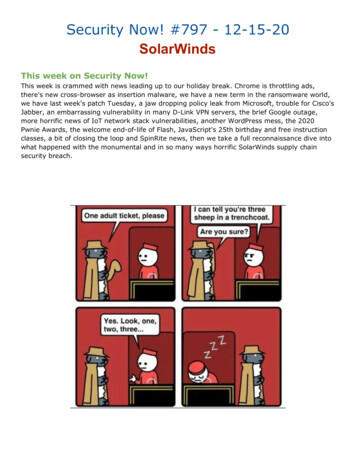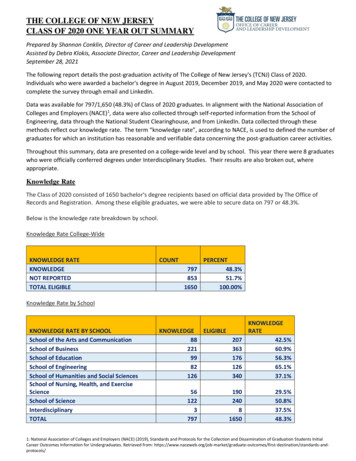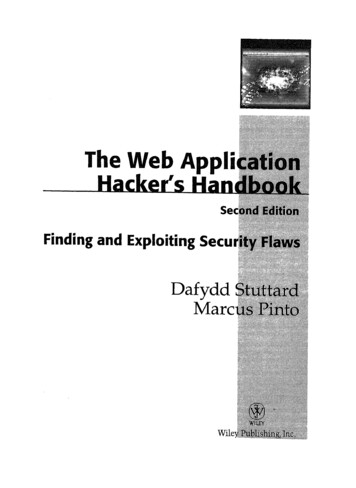
Transcription
Security Now! #797 - 12-15-20SolarWindsThis week on Security Now!This week is crammed with news leading up to our holiday break. Chrome is throttling ads,there's new cross-browser as insertion malware, we have a new term in the ransomware world,we have last week's patch Tuesday, a jaw dropping policy leak from Microsoft, trouble for Cisco'sJabber, an embarrassing vulnerability in many D-Link VPN servers, the brief Google outage,more horrific news of IoT network stack vulnerabilities, another WordPress mess, the 2020Pwnie Awards, the welcome end-of-life of Flash, JavaScript's 25th birthday and free instructionclasses, a bit of closing the loop and SpinRite news, then we take a full reconnaissance dive intowhat happened with the monumental and in so many ways horrific SolarWinds supply chainsecurity breach.
Browser NewsChrome's Heavy Ad InterventionChrome has begun rolling out its so-called “Heavy And Intervention” in Chrome 87. It's beingspotted in the wild by some lucky users, and it affects both 3rd party ads and Google's ownAdSense equally.It's being rolled out gradually, and it wasn't yet enabled in my Chrome, but I definitely wantedit, so I turned it on. Anyone may do so by going to chrome://flags and search for “heavy ad”which will return two settings. They were both set to default, so I enabled the first and disabledthe second:The second option appears to make Chrome’s intervention less certain so that the presence ofheavy ad blocking cannot be used as a tracking beacon.AdrozekLast Thursday, Microsoft's 365 Defender Research Team posted a blog titled: “Widespreadmalware campaign seeks to silently inject ads into search results, affects multiple browsers.”Microsoft named this malware “Adrozek” and one of the things that makes this malwarenoteworthy is that it is cross-family multi-browser, affecting Edge, Chrome, Yandex and Firefox.And although its most prominent feature is unwanted ad injection, it not only injects ads, but themalware also exfiltrates any of the browser's stored credentials, which can cause significantlymore harm than some unwanted ads injected into search results.Microsoft wrote:We call this family of browser modifiers Adrozek. If not detected and blocked, Adrozek addsbrowser extensions, modifies a specific DLL per target browser, and changes browser settingsto insert unauthorized ads into web pages, often on top of legitimate ads from search engines.The intended effect is for users, searching for certain keywords, to inadvertently click on thesemalware-inserted ads, which lead to affiliated pages. The attackers earn through affiliateadvertising programs, which pay by amount of traffic referred to sponsored affiliated pages.Cybercriminals abusing affiliate programs is not new—browser modifiers are some of the oldesttypes of threats. However, the fact that this campaign utilizes a piece of malware that affectsmultiple browsers is an indication of how this threat type continues to be increasinglySecurity Now! #7971
sophisticated. In addition, the malware maintains persistence and exfiltrates websitecredentials, exposing affected devices to additional risks.The malware is surprisingly sophisticated. It disables browser updates to prevent itsconfiguration modifications from being reversed, and it even establishes a Windows service togain persistence over the long term.The bad news is, before effective safeguards were put in place, Adrozek’s sophistication allowedit to compromise more than 30,000 PCs per day. The good news is, as Microsoft's securitypeople become aware of these threats, so does the Windows Defender protection suite. So itmight be a good idea, just for some peace of mind, to ask Defender to perform a full scan ofyour various Windows systems.(By the way, full scans take time. There’s no way around that. As the author of SpinRite, I’m alltoo aware! Defender says to go ahead and use your PC while it scans in the background. But itaggressively throttles its scanning so as not to interfere with your use of the computer in theforeground. So it’s best to choose a time when you’re about to be away from your machine. Inthat case Defender will zoom along at best speed.)I took my own advice and “Full Scanned” my Win10 machine last night while I was assemblingthese notes. It took 90 minutes and scanned 5,797,899 files Leo. after the scan was finished, I just stared at that number. I remember (fondly) when ourhard drives had seven files. Now the number of files has seven digits. I do miss those days.Ransomware News“Double Extortion”On the ransomware front, I just wanted to note the emergence of a new term coined by thesecurity industry: “Double Extortion.” It originated with CheckPoint last April to refer to thedouble threat of encryption plus public exposure of proprietary data if the victim should choosenot to pay up. As we know, some companies will be extremely sensitive to the reputationdamage — not to mention the potential liability — if the news of their breach should becomewidely known. So, henceforth, that embarrassment strategy will be termed “double extortion.”Security NewsPatch Tuesday RetrospectiveYour first thought upon hearing that last week Microsoft patched 58 known vulnerabilities acrosstheir various products you might think, “Wow! Only 58 this month! That's way fewer than themore than 100 we've been beaten into accepting as normal this year!” But then, when you stopto look closer, you realize that fully more than one third of those — 22 in total — are remotecode execution (RCE) vulnerabilities!! And because several are in Exchange Server andSharePoint, I hope everyone has by now made time to get these updated. Although none are0-days, meaning that none are known to be under exploitation at the time of their discovery, aSecurity Now! #7972
total of 9 are rated critical, and some are not difficult to exploit once they become known. Weknow that bad guys rejoice every month now, and quickly work to reverse engineeringMicrosoft's updates in hope of working out an effective exploit before hapless Windows usersupdate their vulnerable machines — especially when they are enterprises running servers thatthey would like to avoid rebooting and having offline during a patch cycle.Among these 58 that Microsoft fixed this month was a bug in Microsoft's Hyper-V virtualizationtechnology. It was exploitable via a malicious SMB packet and would allow remote attackers tocompromise virtualized sandboxed environments, which Hyper-V was designed to protect.So, yes, as always. Don't wait long to update.And speaking of Microsoft updates, here’s a little bit of tid that caught my eye The news was about a 0-click wormable vulnerability in Microsoft Teams. Before this was fixed itwould have allowed an adversarial attacker to remotely compromise a target's machine simplyby sending them a specially-crafted hat message. The reception of this message would haveenabled zero-click remote code execution on that system. This discovery was reported toMicrosoft at the end of August, on the 31st, by Oskars Vegeris, a security engineer withEvolution Gaming. Microsoft addressed the issue at the end of October.In Oskars' write up, he said: “No user interaction is required, exploit executes upon seeing thechat message. The result is a complete loss of confidentiality and integrity for end users —access to private chats, files, internal network, private keys and personal data outside MSTeams.”And. the RCE is cross-platform — affecting Microsoft Teams for Windows (v1.3.00.21759),Linux (v1.3.00.16851), macOS (v1.3.00.23764), and the web (teams.microsoft.com) — and canbe, as I said, made wormable. So it could be propagated by automatically reposting themalicious payload to other channels. This means the exploit can be passed on from one accountto a whole group of users, thereby compromising an entire channel. So it's bad, right?Now here's the tasty bit: This quite serious, 0-click, wormable, remote code executionvulnerability was assigned no CVE designation by Microsoft. Why? Microsoft said — and I quote— "It is currently Microsoft's policy to not issue CVEs [for flaws in] products that automaticallyupdate without user's interaction."Wait. What?!?!Leo. I haven't tracked down this apparent policy change. But it would be VERY interesting foryou to ask Paul and MaryJo about this tomorrow. Could Microsoft's “solution” to theembarrassment of hundreds of CVE's being patched every month be to redefine problems bywhether or not they are automatically repaired? If so. this is a whole new ballgame. This wouldsuggest that anything that auto-updates — like Windows — would no longer have any actualvulnerabilities. After all, Windows is now a continually moving target that's always in flux. So,those are not actually vulnerabilities at all. They're just some miscellaneous things — likeremotely taking over a Microsoft Teams user by sending them a Chat message — that haven'tbeen finalized yet. But don't worry, we're working on it. It's not worth bothering yourself about.Security Now! #7973
Cisco is Jabbering.Cisco has also been having recurring trouble keeping Chat secure. They have again attempted topatch their Jabber conferencing and messaging application against a critical vulnerability thatmade it possible for attackers to execute malicious code that would spread from computer tocomputer with no user interaction iv/cisco-jabber-vulnerabilities-resurface/The discoverers of the trouble. Watchcom Security, explained what's been going on:The TL;DR is: Three months ago, Watchcom disclosed four high severity vulnerabilities in CiscoJabber. One of the vulnerabilities allowed Remote Code Execution (RCE) by sending speciallycrafted chat messages — a problem that everyone seems to be having. The vulnerabilitieswere reported to Cisco and a patch was issued. Shortly after, one of Watchcom’s clientsrequested a verification audit of the patch to ensure that the vulnerabilities had beensufficiently mitigated. Whoops!Three of the four vulnerabilities Watchcom disclosed in September have NOT been sufficientlymitigated! “Hello Cisco. Are you listening? Is anyone home?” Watchcom reported that Ciscoreleased a patch that fixed the injection points they had reported, but the underlying problemwas not fixed. And consequently, Watchcome was able to find new injection points that couldbe used to exploit the same vulnerabilities. All currently supported versions of the Cisco Jabberclient (12.1 - 12.9) are affected.For the sake of clarity, the three new(ish) vulnerabilities have been assigned new CVE numbersto distinguish them from the original similar vulnerabilities disclosed last September.Watchcom explained that the new(ish) vulnerabilities have the same impact as the original andrange in severity from medium to critical. As such, two of the vulnerabilities can be used to gainremote code execution.The most severe vulnerability is a Cross Site Scripting (XSS) vulnerability that can be used toachieve RCE by escaping the Chromium Embedded Framework (CEF) sandbox. This vulnerabilitydoes not require user interaction and is wormable, since the payload is delivered via an instantmessage. This means that it can be used to automatically spread malware without any userinteraction.The second vulnerability can be exploited to collect NTLM (NT LanMan) password hashes fromunsuspecting users. In a very clever hack. by sending a message that contains a malicious img tag, an attacker can induce the victim’s Cisco Jabber client to interact with a file shareunder the attacker's control. If the file share requires authentication, the victim’s NTLM passwordhash will be sent.The 3rd vulnerability involves the custom protocol handlers used by Cisco Jabber. These protocolhandlers are vulnerable to command injection because they fail to consider URLs that containspaces. By including a space in the URL, an attacker can inject arbitrary command line flags thatwill be passed to the application. Since the application uses CEF (the Chromium EmbeddedSecurity Now! #7974
Framework) and accepts Chromium command line flags, several flags that can be used toexecute arbitrary commands or load arbitrary DLLs exist. Whoopsie.While Cisco's first patch filtered some of these, Watchcom was still able to identify a dangerousflag that could bypass the filter. The flag can be used to enable remote debugging, allowing anattacker on the same network to take control of the embedded browser in the victims CiscoJabber client.Watchcome wrote something in the conclusion of their disclosure that I thought was worthy ofthe whole story. They wrote:The continued existence of these vulnerabilities, even after the first patch, highlight thecomplexity of modern software and the challenges developers face when trying to secure it.When choosing to use frameworks such as CEF, it is important to consider their securityimplications. Security should also be considered in every step of the development process,both in the initial planning stages as well as during implementation and maintenance.This also serves as a reminder that software acquired from external vendors also pose a risk toorganizations’ IT-security. It is important to be aware of these risks and take steps to mitigatethem. Watchcom recommends regular audits of third-party software for securityvulnerabilities.Amen to all of that.An embarrassing vulnerability in D-Link VPN serversThe embarrassing vulnerabilities — yes, three of them — were discovered by the guys at DigitalDefense and were subsequently responsibly disclosed to D-Link four months ago on August 11th.D-Link finally confirmed the issues in an advisory on December 1, adding that patches wereunder development for two of three flaws which have now been released to the public.The flaws are high-risk (as I said, embarrassing!) critical security vulnerabilities affectingD-Link's widely sold VPN router models DSR-150, DSR-250, DSR-500, and DSR-1000AC andother VPN router models in the DSR Family, running the current firmware versions 3.14 and3.17. Even if these devices are secured with strong passwords, the vulnerabilities have leftmillions of home and business networks open to attack. Because they provide a fullauthentication bypass, allowing remote attackers to execute arbitrary commands on thosedevices through specially-crafted requests.Did I mention that these were particularly embarrassing? The flaws originate from the fact thatthe web management interface uses “Lua CGI” which is fully accessible without authenticationand lacks any server-side filtering. This makes it possible for an unauthenticated attacker toinject malicious commands that will be executed with root privileges. And this works over theInternet-facing WAN interface.The takeaway for our listeners is that if you or your enterprise are using any of these quitepopular D-Link VPNs, be sure to obtain and update to the most recent firmware with somepriority.Security Now! #7975
Google suffered an outage — nothing to see here. These are not the droids you’re looking for.The conspiracy folks stepped right up with various attack nonsense. But Google quickly dispelledthose theories. They first acknowledged the trouble at 4:20am Pacific Time, posting:"We're aware of a problem with Gmail affecting a majority of users. The affected users areunable to access Gmail. We will provide an update by December 14, 2020 4:12:00 AM PSTdetailing when we expect to resolve the problem. Please note that this resolution time is anestimate and may change."Then, about 3 hours later, at 7:30am Pacific Time, they updated:“Today, at 3:47am PT Google experienced an authentication system outage for approximately 45minutes due to an internal storage quota issue. This was resolved at 4:32AM PT, and all servicesare now restored.”So, unusual as that was, it was no attack, nothing untoward. Just whatever that was.Amnesia:33Last Wednesday, during BlackHat Europe 2020, researchers from Forescout Technologiespresented their paper titled: “How Embedded TCP/IP Stacks Breed Critical Vulnerabilities”In their teaser synopsis they wrote:In the past few years, there's been a rise in critical vulnerabilities affecting embedded TCP/IPstacks which had remained undiscovered for over a decade. The direct, unauthenticated andsometimes cross-perimeter network exposure of these stacks, the often privileged portions ofthe system they run in and their position at the top of opaque supply chains complicatingvulnerability management efforts make for a highly dangerous mix resulting in periodic wavesof critical vulnerabilities affecting billions of devices across industry verticals. But contrary towhat many assume, the fragility of these fundamental components isn't limited to specificvendors or older, closed-source stacks alone.In this talk, we will present over a dozen new vulnerabilities in multiple widely used embeddedTCP/IP stacks deployed in everything from networking equipment and medical devices toindustrial control systems. We will discuss the nuances in their exploitability & potential impactand demonstrate a proof-of-concept against a yet-to-be-disclosed high profile target. Inaddition, we will present the first quantitative & qualitative study into vulnerabilities affectingembedded TCP/IP stacks showing a clear pattern to the affected components & features aswell as the root causes of the vulnerabilities that affect them. Finally, we will provide concreteadvice on how to mitigate and manage vulnerabilities affecting billions of devices in theabsence of centralized patching and notification efforts.Needless to say, that's quite a -Vulnerabilities-wp.pdfSecurity Now! #7976
That's the introduction to their 47-page paper. Stepping back a bit, they coined the name“Amnesia:33” because they uncovered a set of 33 vulnerabilities collectively impacting fourdifferent open-source TCP/IP protocol stacks — uIP, FNET, picoTCP, and Nut/Net — arecommonly used in Internet-of-Things (IoT) and embedded devices. As a consequence ofimproper memory management, successful exploitation of these flaws could cause memorycorruption, allowing attackers to compromise devices, execute malicious code, performdenial-of-service (DoS) attacks, steal sensitive information, and even poison DNS cachememory. In real world scenarios, these attacks could play out in various ways: disrupting thefunctioning of a power station to result in a blackout or taking smoke alarm and temperaturemonitor systems offline by using any of the DoS vulnerabilities.Many millions of devices from an estimated 158 vendors are vulnerable to the AMNESIA:33discoveries, with the possibility of remote code execution allowing an adversary to take completecontrol of a device, and using it as an entry point on a network of IoT devices to then movelaterally, establish persistence, and co-opt the compromised systems without any outwardappearance of compromise.If we imagine that nation-state actors are greedily mopping up all available exploits everrywherethey appear, then this research from Firescout was likely greeted with a great deal of mopping.Forescout said that “AMNESIA:33 affects multiple open source TCP/IP stacks that are not ownedby a single company. This means that a single vulnerability will exist across multiple codebases,development teams, companies and products, which presents significant challenges to patchmanagement.”Because these vulnerabilities span a complex IoT supply chain, Forescout cautioned it's aschallenging to determine which devices are affected as they are hard to eradicate. TheAMNESIA:33 flaws stem from out-of-bounds writes, buffer overflows, and lack of inputvalidation. They lead to memory corruption, enabling an attacker to put devices into infiniteloops, poison DNS caches, and extract arbitrary data.Critical remote code execution vulnerabilities exist in uIP, picoTCP, and Nut/Net. Each has aCVSS score of 9.8. Some of the vendors who utilize these stacks are being responsible. Vendorssuch as Microchip Technology and Siemens whoSe products are affected by these vulnerabilitieshave released security advisories.As Forescout put it: “Embedded systems, such as IoT and [operational technology] devices, tendto have long vulnerability lifespans resulting from a combination of patching issues, long supportlifecycles and vulnerabilities 'trickling down' highly complex and opaque supply chains. As aresult, vulnerabilities in embedded TCP/IP stacks have the potential to affect millions – if notbillions – of devices across vertical markets and tend to remain a problem for a very long time.”The problems are severe enough for the CISA to get involved and to urge awareness. But thatdidn't appear to have much impact when they had urged companies to update against theMicrosoft ZeroLogon vulnerability. Asking IoT vendors to path their unpatchable devices seems aclearly doomed exercise in futility.My feeling is that we MUST treat IoT gadgets with the assumption that they are compromisedand rigorously relegate them to their own isolated networks.Security Now! #7977
If you can access your various IoT devices from outside your home then it's clear that you andthey do not need to share a common network. Your untrusted IoT LAN should coexist with yourtrusted LAN, but they should not have any contact with one another.Another WordPress messI got a kick out of the subhead that ZDNet chose. Their headline was: “Zero-day in WordPressSMTP plugin abused to reset admin account passwords.” and their sub-head was: “A patch wasreleased earlier this week but many WordPress sites remained unpatched —as usual.”So, first off, as we know, the term “0-day” has unfortunately become synonymous with “bug”.The press is tending to call everything a 0-day because it sounds a lot more serious. It wasmeant to. But referring to everything as a 0-day will ultimately render the term worthless.In this case, refreshingly, it really is a 0-day. Hackers have been using a design mistake coupledwith a dumb configuration setting of a popular WordPress add-on to easily reset the adminpasswords on WordPress sites. And the add-on is considered popular because it's installed onmore than 500,000 sites. The hacking has been underway for some weeks and a patch for thedesign error was made available last Monday — thus, a true 0-day vulnerability.The add-on in question is “Easy WP SMTP” — obviously a plugin that lets site owners configurethe SMTP settings for their website's outgoing emails and add features.One of the several features it boasts is the: “Option to enable debug logging to see if the emailsare getting sent out successfully or not.” That feature causes the system to log all eMail headersand body that is sent. And that eMail log is located in the plug-in's well-known installationdirectory “/wp-content/plugins/easy-wp-smtp/”. Thus that's no -wp-smtp-plugin-fixed-zero-day-vulnerability/But, the team at Ninja Technologies Network (NinTechNet) discovered that although Easy WPSMTP v1.4.2 and older — which was current before last week's update — gives the log a fancyrandom name like “5fcdb91308506 debug log.txt”, the plug-in's folder lacks any index.html file.So when the site is being hosted on servers with directory listing enabled, hackers can view thedirectory, see the fancy-named eMail log, and view its contents. Then, they cause the bloggingsite to send its administrator a password reset eMail, refresh the view of the sent eMail log,capture the password recovery link and take over the site.I mentioned before that while I was hosting my own WordPress blog, I was horrified by the ideaof the site's admin login form being public. The idea that anyone could enter the well-known URLof the admin logon and be looking at a prompt for a username and password to login as me wasappalling. So, one of the first “belt and suspenders” things I did, was to completely block accessto any admin-related pages — first and foremost the front door — from any remote IPs otherthan mine. As we know, the public IPs we're assigned by ISP are relatively static, so it's just assimple as using an .htaccess or in my case a web-config file for IIS to filter incoming pagerequests. If my IP did happen to change so that I was also locked-out, then I would need to logonto the hosting server itself — which I would do using a certificate-tied SSH client — not merelya username and password — to update the access control with my new remote IP.Security Now! #7978
My point is, I'll never know what attacks that bit of superstition might have thwarted. But theidea of exposing my WordPress login page to the world just made me shiver. as I hope it wouldfor any of our listeners.The 2020 Pwnie AwardsSpeaking of Black Hat Europe 2020, the annual Pwnie awards were announced last week duringthe conference. For those who don't recall, the Pwnie's are to our cyber-security industry whatthe Oscars and the Razzie awards are to the movie industry.Each year, cyber-security researchers are invited to nominate and vote for both the best andworst in their industry. This includes selecting the best and most ingenious vulnerabilitiesdiscovered during the past year, and also the worst vendor responses and epic fails that puttheir users at risk.Traditionally, the Pwnie Awards ceremony has taken place every August during the Black HatUSA security conference in Las Vegas. But this year, with the COVID-19 pandemic virtualizingconferences, it was decided that the Pwnie Awards would be moved to Europe's Black Hatconference. Among the results are the many things we've talked about during the year: Best server-side bug: BraveStarr - a remote code exploit in the Telnet daemon on Fedora 31servers. Best client-side bug: For a zero-click MMS attack on Samsung phones, bug discovered by theGoogle Project Zero team. Best privilege escalation bug: Checkm8 - an unpatchable hardware jailbreak for sevengenerations of Apple silicon. Best cryptography attack: Zerologon - a bug in Microsoft's Netlogon authentication protocolthat can be performed by adding adding a bunch of zero characters in certain Netlogonauthentication parameters. Most innovative research: TRRespass - bypassing TRR protections on modern RAM cards tocarry out Rowhammer attacks. Most epic fail: Microsoft for CurveBall, a bug in how the company implemented elliptic curvesignatures on Windows, allowing for easy spoofing of HTTPS sites and legitimate apps. Epic achievement: To Guang Gong, a known Chinese bug hunter, for discoveringCVE-2019-5870, CVE-2019-5877, CVE-2019-10567, three bugs that allowed remotetakeovers of Android Pixel devices [see PDF].Not a Flash in the panAdobe's infamous flash player was anything but a flash in the pan. It was first released 24 yearsago in January of 1996. Back then, web pages were predominantly static HTML. JavaScript wasjust beginning to happen, but it didn't have any of the new browser features to drive. So itsSecurity Now! #7979
application back then was very limited. But Flash added a complete self-contained contentauthoring, locally interactive and animating facility. You could write a working game in Flash —and many developers did. Because it was a world unto itself, it was inherently browser agnostic.If a browser had a Flash plug-in, the content would run. It really was quite something for theera, and it was immediately adopted by developers to create interactive content for the web.Flash's Achilles' heel, as we all know too well, was that it was originally written, like most of thesoftware of the time, with virtually no regard for security. And it was never able to recover fromthat lack of security legacy. It was much like the Internet back then. the fact that it ran at allwas regarded as a miracle. Security wasn't even a thought, let alone an after thought.But thanks to the incredible progress made in turning our browsers into fully programmable webapplication hosting containers, driven by JavaScript, more than 1,444,231 add-on JavaScriptfunction libraries, and a very mature and formalized Document Object Model that allows a webpage's presentation to be fully accessible and manipulatable by JavaScript. the only thing thathas kept Flash alive has been the residual inertia still remaining from its once total dominance.So, against that backdrop, last week Adobe released their final update EVER of their Flashplayer, and reminded the world that Flash is finally, once and for all, being extinguished forever.And it's not as if no one has received notice. It was way back in 2017 that Adobe, Microsoft,Google, Apple, and Mozilla made a joint announcement that they would be retiring support forAdobe Flash Player at the end of 2020.In their final Flash Player release notes, Adobe said: “We want to take a moment to thank all ofour customers and developers who have used and created amazing Flash Player content over thelast two decades. We are proud that Flash had a crucial role in evolving web content acrossanimation, interactivity, audio, and video.”So, beginning next month, Chrome, Safari, Firefox, Edge, IE11, and other Chromium-basedbrowsers will remove Flash from their bodies and it will become impossible to put it back. Solong and farewell. Whew!JavaScriptAnd while I'm on the topic of browser coding and automation, JavaScript is celebrating its 25thbirthday and we're in the second week of free courses being offered every week atJavaScript.com:https://www.javascript.com/The site says: To celebrate one of the most popular languages in the world, we're making five ofour expert-authored JavaScript courses free every week in December.Security Now! #79710
Closing The LoopDavid P. Vallee @YossarrianHi Steve, Listened to the Amazon Sidewalk podcast. Sounds like Amazon did everythingimaginable to prot
Microsoft named this malware "Adrozek" and one of the things that makes this malware noteworthy is that it is cross-family multi-browser, affecting Edge, Chrome, Yandex and Firefox. . malware-inserted ads, which lead to affiliated pages. The attackers earn through affiliate advertising programs, which pay by amount of traffic referred to .











